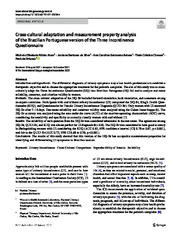Cross-cultural adaptation and measurement property analysis of the Brazilian Portuguese version of the Three Incontinence Questionnaire

Visualizar/
Data
2022-01-05Autor
Alem, Michele Elisabete Rubio
Silva, Jordana Barbosa da
Beleza, Ana Carolina Sartorato
Chaves, Thais Cristina
Driusso, Patricia
Metadata
Mostrar registro completoResumo
Introduction and hypothesis The differential diagnosis of urinary symptoms may allow health professionals to establish a therapeutic objective and to choose the appropriate treatment for the patient's complaint. The aim of this study was to cross-culturally adapt the Three Incontinence Questionnaire (3IQ) into Brazilian Portuguese (3IQ-Br) and to analyze test-retest reliability, construct, and criterion validity in women.
Methods The cross-cultural adaptation of the 3IQ-Br included forward-translation, back-translation, and consensus among an expert committee. Participants with and without urinary incontinence (UI) completed the 3IQ-Br, King's Health Questionnaire (KHQ), and Questionnaire for Female Urinary Incontinence Diagnosis (QUID-Br). Only women with UI answered 3IQ-Br after 7–10 days. Test-retest reliability and construct validity were analyzed using the Cohen linear kappa (k). The 3IQ-Br accuracy was analyzed using the area under the curve (AUC) of the receiver-operating characteristic (ROC) curve,
considering the sensitivity and specificity to correctly classify women with and without UI.
Results The reliability of each question from the 3IQ-Br was considered substantial in the test-retest. The agreement among 3IQ-Br, QUID-Br, and KHQ was almost perfect for UI diagnosis (k > 0.8). The 3IQ-Br was considered to have good accuracy in distinguishing women with UI considering the KHQ (AUC 0.83, 95% confidence interval [CI] 0.78 to 0.87, p < 0.001), and fair to the QUID-Br (AUC 0.73, 95% CI 0.68 to 0.78; p < 0.001).
Conclusions The results of this study showed that this version of the 3IQ-Br has acceptable measurement properties for identifying and differentiating UI symptoms in Brazilian women.
Collections
Os arquivos de licença a seguir estão associados a este item:
